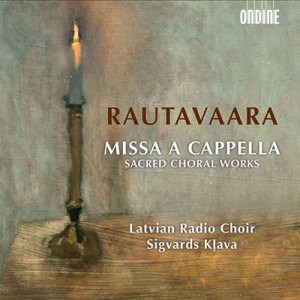Einojuhani Rautavaara (1928-2016) is often referred to as the most important Finnish composer since Sibelius. While that’s certainly true, he stands without qualification among the great composers (not just Finnish ones) of the past 60 or 70 years. And unlike many of his peers and predecessors (including Sibelius), his work focused as much on choral and vocal music as it did on symphonic creations. Ondine has recorded most of these works, many of which we’ve already reviewed (see reviews archive), and this disc, recorded in 2013, marks what appears to be the last of those devoted to Rautavaara’s choral music.
I should note that an earlier, and very fine, Ondine recording from 1999 with the Finnish Radio Chamber Choir contains several of these same works (see reviews), but not necessarily the same versions. While the Missa duodecanonica that appears on both programs is the same—sung by women’s voices—the earlier Ave Maria (also a 12-tone work) was written in 1957 for male choir; it appears on this release in a new version for mixed voices, titled Ave Maria, gratia plena. The Credo from the earlier disc is from 1972—Rautavaara intended this as part of an entire Mass setting, which, titled Missa a cappella, he finally completed for its premiere performance in 2011. The Psalm of Invocation and Evening Hymn, present on both recordings, are from a larger work (Vigilia); on the earlier recording they are sung in the original Finnish—on this new one they are sung in English versions.
These last two pieces are excellent examples of Rautavaara’s sensibility regarding religious music and his facility for invoking a certain spirit or atmosphere to enliven the texts, whether a cry to be heard or a quiet prayer. In the 1999 recording we have the advantage of notes written by the composer. He explains the connections in the music, including the sudden, strange-sounding glissandos in the Psalm (they “hark back to the singing of the early Christian church”), while the use of low bass in the Evening Hymn is a reflection of the “Russian Orthodox tradition.” The writing is such that we might have suspected this, but it confirms his awareness of and sensitivity to the purpose and meaning of what he’s writing.
While the Missa a cappella will likely draw greatest interest from devotees of this composer—this claims to be its world-premiere recording, and remains the only one in the catalog so far—I vote for the Canticum Mariae Virginis as the program’s most striking in its use of voices and structural devices to create a uniquely vocal world of sound and expressive power that, even though it was composed in 1978, still sounds original, and new. And never is there, over nearly nine minutes in this performance, a note or passage or idea that doesn’t seem to flow naturally from what comes before.
Rautavaara describes the textural construct of this and other of his works as a “sound field”, which most listeners would describe as “tone clusters”—certainly not a new idea, but as he employs the technique here, as a foundation (sung by middle voices) for “an expressive dialogue” between soprano and bass, it makes an uncannily ethereal, timeless effect. This same work is sung on the earlier disc, and while it certainly is respectable enough, the current performance, nearly a minute and a half slower, is notably more dynamic: those sopranos rising out of the ether and the eventual climax of their line with the basses makes an unforgettable impression.
The Missa a cappella, which comes first on the program, is undoubtedly one of Rautavaara’s finest works, one that represents the refinement of what is described as the composer’s “late-period Neo-Romantic synthesis style”. This includes tonal, predominantly homophonic structures, but with much use of those “sound fields”, bundles of close intervals that color the basic harmonies with a pleasingly dissonant edge, while solo melodic lines often rise over or run underneath. Yet some movements—the Gloria; the Credo—have a more “traditional” character and harmonic treatment while still incorporating more “modern” rhythmic ideas and unconventional harmonies. The Sanctus owes much, from its tenor solo to its fundamental harmonic structure, to that above-mentioned “Orthodox tradition”.
This is an essential collection of Rautavaara’s choral music covering a period of nearly 50 years, from 12-tone experimentation in the 1960s to the highly individualistic tonal style he developed during the 1970s. Interestingly, even in the serial stuff Rautavaara somehow sidesteps the most off-putting angular, edgy, ambiguous features so highly prized by the 1960s-’70s avant-garde crowd; the 12-tone works presented here are actually listenable as “real” music, not just as academic exercises. And fortunately, after this period Rautavaara decided to move on in a direction much richer in creative—and audience-friendly—possibilities.
Sigvards Klava’s Latvian Radio Choir is the ideal advocate for this music—and Ondine’s first-class engineering, capturing the very complementary acoustics of a Riga church, set the seal on a fitting tribute to this great composer. Highly recommended. Don’t miss it.
































